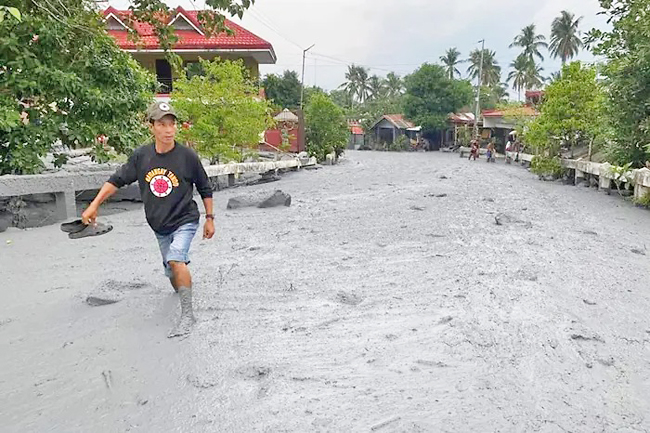MANILA (AFP) – Heavy rain washed volcanic mud and debris through a village in the central Philippines yesterday, two days after a nearby volcano erupted.
Mount Kanlaon on Negros island exploded on Monday evening, sending a plume of ash, rocks and gases five kilometres into the sky.
Images posted on Facebook show a torrent of grey mud and rocks, known as cold lava flow, or lahar, roaring down a watercourse in Biaknabato village in Negros Occidental province.
Residents can be seen walking barefoot through thick sludge covering a road in the village, located a few kilometres from the volcano.
“The lahar on the streets is knee-deep,” Stills Fernandez of the municipal disaster agency told AFP.
A bulldozer and three dump trucks were deployed to remove the lahar after it stopped flowing but Fernandez said it “might take time” to clear. There were no immediate reports of casualties.

Lahars are mammoth flows of volcanic debris deposited on a volcano’s slopes and unleashed by heavy rain or snow melt. They can bury villages.
“We are still determining the extent and volume of the lahar,” said director of the Philippine Institute of Volcanology and Seismology Teresito Bacolcol.
Bacolcol warned the public that lahar contained volcanic ash and was “dangerous”.
Leah Martinez, 37, filmed the stream of volcanic debris flowing down a rocky watercourse near her village of Masulog, which is also close to the volcano.
“Before the lahar flow, there was a thunder-like sound again,” Martinez told AFP. “I rushed outside. It was so loud. I thought the volcano had erupted again,” she said.
“We couldn’t see anything at first, then there were large stones, ashes and water flowing down the river”.
It was not clear if other villages were affected or how many houses were damaged.
Hundreds of people have been evacuated from their homes around Mount Kanlaon due to falling ash and gases.





